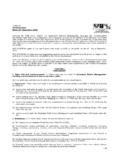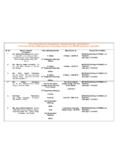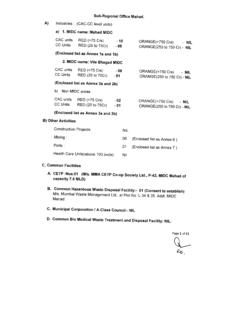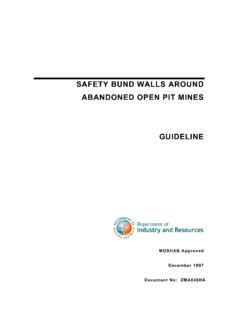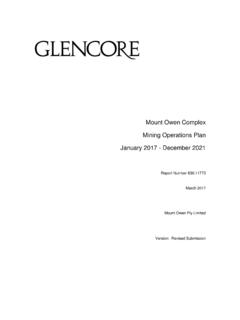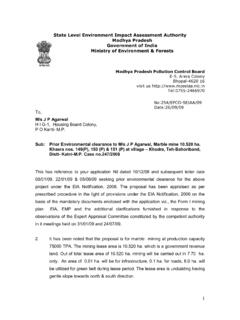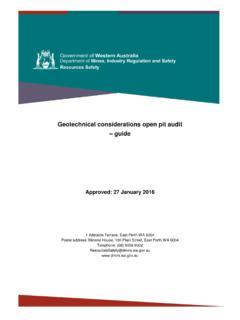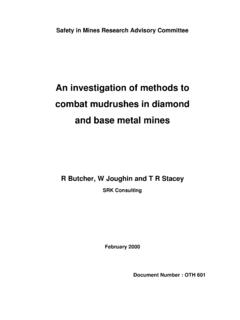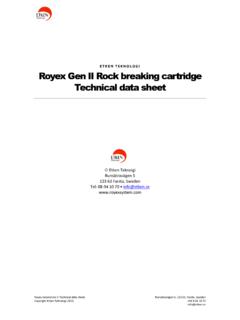Transcription of GUIDELINES FOR PERMITTING QUARRIES-R1
1 GUIDELINES FOR ENVIRONMENTALLY SOUND OPERATIONS FOR STONE QUARRIES MAHARAHTRA POLLUTION CONTROL BOARD KALPTARU POINT, SION (E), MUMBAI- 400 022 DECEMBER 2006 GUIDELINES FOR STONE QUARRYING Preamble: The requirement of the stone is increasing with demands from rapidly growing infrastructural projects and housing sector. The stone is exploited from the quarries and many a times crushed at the site for getting necessary sizes. The stone is treated as minor minerals and therefore the stone quarrying do not attract the provisions of Environmental protection act. The stone mining areas a re generally identified by the mining department and Collector, through the mining department regulate the operation of stone quarries. The operations of the quarries has operations including, blasting 1. No quarrying operations shall be carried out without obtaining Development Permission of the Planning Authority/District Collector/ Sub- Divisional Officer/ Tehsildar 2.
2 The application for Development Permission for quarrying shall include:- a. A Location/site Plan at 1:500 scale of the quarry site and an area up to 500 meters around the quarry site showing important natural and man made features and contours and other important landscape features, access roads, building and other structures; b. Proposed excavation plan and cross sections at 1:500 or larger scale showing proposed phasing; terracing; stepping; benching slopes; locations of process equipments; diversion of water courses; impounding lake; storage areas for top soil, waste material, quarried material; workers housing; landscaping including screen planting, mounding and measures against visual intrusion etc. c. A restoration plan including landscaping proposals, phasing and proposal for reuse of the area after quarrying.
3 D. A report supplementing the excavation and restoration plans, costs and implementation program 3. No quarrying shall commence until the excavation plan is approved by the Director of Geology and mining 4. The Restoration Plan approved by the Planning Authority/ District Collector/ Sub- Divisional Officer/ Tehsildar shall be implemented in consultation with concerned Conservator of Forest of District Forests Officer. 5. Natural gradient of slope should be maintained during quarrying operations, slope of the footwall side (Slope in the direction in which mining does not exist) should be properly stabilized by planting adequate number of tress of suitable species in consultation with local Forests Department so as to have soil binding vegetation 6. In the case of murrum, the entire weathered soil or murum shall not be excavated leading to exposure of hard rock, instead, a capping or at least half a meter layer of murrum shall be left so that it can support vegetation and plantation that will be done later on.
4 7. Water course, if any, from a higher slope, should be properly diverted out of quarry and shall be safely channeled out of any nearby human settlement. 8. During quarrying operations, the water should be sprayed at least once in a day over the roads at the quarry sites and nearby areas. 9. Kachha road, used for transportation of murrum, from the quarry site shall be invariably sprayed by water during these operations. In order to minimize dust pollution, measures such as adoption of hoods at transfer points, vulcanizing of conveyer belt joints, under belt cleaning devices, and installation of dust suppressions and/or dust extraction system for conveyance shall be adopted. 10. The kachha road leading to the quarry shall have avenue plantation on to arrest the dust pollution. 11. No blasting shall be permitted if a public road, railway line or any human settlement is located within 500 meters from the quarrying site.
5 12. Residences for laborers and related temporary structures should be constructed at least 500 meters away form the place of blasting as well as from the place of quarrying. Heavy blasting using the heavy machinery shall be prohibited. 13. The Development Permission for quarrying shall be granted for a specific period, after which fresh permission for further quarrying will be necessary. In granting such fresh permission, the Planning Authority/ District Collector/ Sub- Divisional Officer/ Tehsildar shall review the performance of the quarry operator in implementing the approved excavation and restoration plans, air pollution control measures undertaken and adherence of these GUIDELINES while carrying out the quarrying operations SPECIFIC GUIDELINES FOR SOURCEWISE POLLUTION CONTROL MEASURES TO BE FOLLOWED FOR STONE QUARRIES.
6 AIR POLLUTION DRILLING : 1) Drilling machine shall be fitted with dust suppression, collection and disposal arrangement. 2) Deep wetting of drilling zones shall be done by water sprinkling before starting drilling. 3) During the drilling operations the efforts shall be made to reduce dust generation by taking appropriate measures blasting 1) Proper blasting whole geometry shall be designed. 2) Blast site shall be wetted before and after blasting operations are completed. 3) Only optimum quantity of permissible explosives shall be used so that the vibrations do not damage the structures/houses if the quarrying operations are close to human habitation. 4) blasting shall be conducted only during favorable weather conditions and only during the day time and permissible hours. 5) The blasting operations shall be given publicity in the local area through Davandi and other available media so that local people become aware of the blasting activities being undertaken in the area.
7 6) The vibrations should be monitored periodically in consultation with the local mining authorities. 7) The storage of the explosives and its transfer to and from the quarry area shall be strictly in accordance with the conditions listed in the permission granted by Explosives Department Heavy Earth moving Machinery(HEMM): 1) The operator/ transporter shall carry out regular maintenance of the machinery and vehicles. 2) The speed limit shall be adhered to. 3) Operator s cabin of the HEMMs should preferably be air conditioned at least air tight. 4) The smoke emission should conform to the standards notified in Motor Vehicle Act. 5) The trucks carrying the mined products shall be covered with tarpaulin so that there are no fugitive emissions during transportation. 6) The transportation should not through the busy roads in the city/towns/villages if by pass roads are available HAUL ROADS : 1) All the haul and service roads shall be mettled and well maintained.
8 2) Unmettled haul roads shall be free of ruts and pot holes. 3) All haul roads and surface roads shall be regularly sprayed with water. 4) Plantation alongside haul roads (avenue plantation) shall be carried out done. 5) Mined material receiving pits are shall be located close to the quarry to reduce the haul length of the dumper OVERBURDEN : 1) Non-operative dumps shall be subjected to technical and biological reclamation. 2) Plantation over and around over burden dumps shall be carried out to ensure stability of slopes, prevention of dust by wind action and soil erosion during the run off. 3) Wetting of surface of O. B. dump shall be regularly practiced. NOISE POLLUTION blasting : 1) Blast holes shall be judiciously charged. 2) No blasting shall be done when there is low cloud ceiling. 3) Millie second delayed detonation to be used.
9 4) All other GUIDELINES of the Explosives department and mining Department regarding blasting operations shall be strictly adhered to. DRILLING : 1) The workers shall be provided appropriate personal protective equipment viz. ear mufflers/ ear plug or noise proof cabins Heavy Earth moving Machinery (HEMM) : 1) The engine exhausts of HWMM to be fitted with mufflers and cabins shall be noise proof. 2) HEMM shall be properly maintained. 3) Operators shall be provided with ear mufflers / ear plugs. 4) Imposition of speed restriction of HEMM near residential area shall be enforced. 5) The haulage path of the HEMM shall be re-routed so that it is away from the residential area. WATER POLLUTION SURFACE: 1) Garland drain around quarry excavations shall be constructed. 2) OBD tops shall be dressed in to a shallow saucer shape 3) Contour drains along slope of OBD dumps shall be constructed.
10 4) OBD run offs shall be desilted through settling tanks before discharge in to natural streams, lakes or any other water body. WORKSHOP: 1) Effluent coming out of workshop shall be treated in a plant containing and Oil/ grease trap (if required) and sedimentation tank. The treated water shall be stored and reused in the workshop itself as far as possible. The treated waste water shall not find its way to the streams, lakes or any other water bodies WORK ENVIRONMENT: Statutory Regulations and GUIDELINES of the Director General of Mines Safety and Department of Explosives shall be strictly followed.


